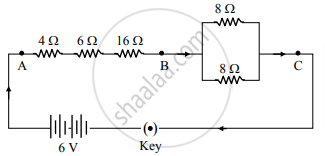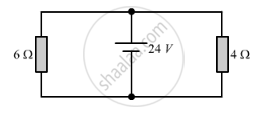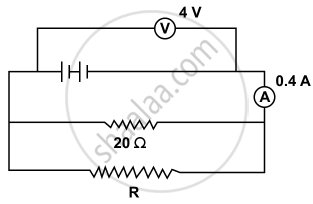Advertisements
Advertisements
प्रश्न
Study the following circuit:

On the basis of this circuit, answer the following questions:
i. Find the value of total resistance between the points A and B.
ii. Find the resistance between the points B and C.
iii. Calculate the current drawn from the battery, when the key is closed
OR
iii. In the above circuit, the 16Ω resistor or the parallel combination of two resistors of 8 Ω, which one of the two will have more potential difference across its two ends? Justify your answer.
उत्तर
i. To find the total resistance between points A and B, we simply add up the resistances in series:
RAB = R4Ω + R6Ω + R16Ω = 4Ω + 6Ω + 16Ω = 26Ω
ii. The resistance between points B and C is a bit more complex because we have two resistances in parallel. We use the formula for resistances in parallel:
`1/R_(BC)=1/R_(8Ω,upper)+1/R_(8Ω,lower)`
`1/R_(BC)=1/(8Ω)+1/(8Ω)= 1/(4Ω)`
`R_(BC) = 4Ω`
iii. To calculate the current drawn from the battery when the key is closed, we need to find the total resistance in the circuit. The total resistance will be the sum of the resistance between A and B and the equivalent resistance between B and C which we found to be
RAB + RBC = 26Ω + 4Ω = 30Ω
Now, using Ohm's Law (V=IR), where V is the voltage of the battery, I is the current, and R is the total resistance, we can find the current:
`I = V/R = (6V)/(30Ω) = 0.2 A`
So, the current drawn from the battery is 0.2 A (or 200 mA).
OR
iii. The potential difference across a resistor in a circuit is given by Ohm's Law, which states:
V = I.R
where V is the potential difference, I is the current, and R is the resistance.
In the given circuit, the 16Ω resistor is in series with two other resistors (4Ω and 6Ω), and the combination of two 8Ω resistors is in parallel. The total resistance in series (4Ω + 6Ω + 16Ω = 26Ω) is greater than the effective resistance of the parallel combination of two 8Ω resistors which is 4Ω, since resistors in parallel have an effective resistance Rparallel given by
`1/R_("parallel")=1/R_1+1/R_2`
Therefore, the series combination (including the 16Ω resistor) has more resistance than the parallel combination, which means it will have more potential difference across it. Since the same current flows through the series resistors, the potential difference across the 16Ω resistor will be the largest among the individual resistors because it has the highest resistance.
So, the 16Ω resistor will have more potential difference across its ends than the parallel combination of two 8Ω resistors.
APPEARS IN
संबंधित प्रश्न
Find the current in each resistor in the circuit shown below:

A 4 Ω coil and a 2 Ω coil are connected in parallel. What is their combined resistance? A total current of 3 A passes through the coils. What current passes through the 2 Ω coil?
Two resistors having resistance 4𝛀 and 6𝛀 are connected in parallel. Find their equivalent resistance.
Calculate the equivalent resistance between the points A and B in Fig. if each resistance is 2·0 Ω.

In the following figure calculate:
- the total resistance of the circuit
- the value of R, and
- the current flowing in R.

Tick (✓) the correct choice among the following :
Consider two cases of two parallel current carrying conductors. Current in
th e same direction and currents in th e opposi te directions will produce
A particular resistance wire has a resistance of 3 ohm per meter. Find the potential difference of the battery which gives a current of 2 A in each of the 1.5 m length when connected in the parallel to the battery (assume that resistance of the battery is negligible).
A piece of wire having a resistance R is cut into five equal parts.
- How will the resistance of each part of the wire change compared with the original resistance?
- If the five parts of the wire are placed in parallel, how will the resistance of the combination change?
- What will be ratio of the effective resistance in series connection to that of the parallel connection?
You are given four ammeters A, B, C and D having the least counts mentioned below:
(I) Ammeter A with least count 0.25 A
(II) Ammeter B with least count 0.5 A
(III) Ammeter C with least count 0.05 A
(IV) Ammeter D with least count 0.1 A
Which of the ammeters would you prefer for doing an experiment to determine the equivalent resistance of two resistances most accurately, when connected in parallel?
Two resistors of resistances 2 Ω and 3 Ω are connected in parallel to a cell to draw current 0.5 A from the cell. Draw a labelled diagram of the arrangement
